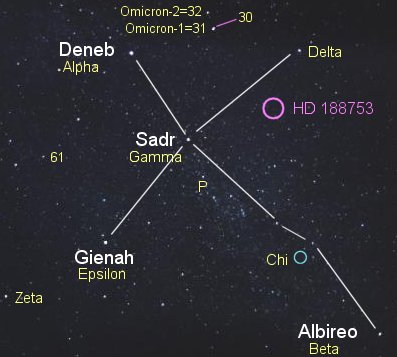 At nearly eighth magnitude, HD 188753 (in the constellation Cygnus is just barely visible at the center
of the labelled circle and requires a telescope or large binoculars
to see. HD 188753 is unique in that the planet orbits within a
triple star system. The planet, a "hot Jupiter," goes around the
primary of the system as does a remarkably-nearby close double
star. How such a system could have developed is a mystery since
the secondary double star should have destroyed the raw material
from which the planet should have formed.
At nearly eighth magnitude, HD 188753 (in the constellation Cygnus is just barely visible at the center
of the labelled circle and requires a telescope or large binoculars
to see. HD 188753 is unique in that the planet orbits within a
triple star system. The planet, a "hot Jupiter," goes around the
primary of the system as does a remarkably-nearby close double
star. How such a system could have developed is a mystery since
the secondary double star should have destroyed the raw material
from which the planet should have formed.
THE PLANET
The planet, with a mass at least 1.14 times that of Jupiter, orbits
very close to the primary (brighter) star of the triple system HD
188753 with a period of only 3.3481 days at a distance of but
0.0446 Astronomical Units (6.7 million miles, 10.8 million
kilometers), 11.5 percent the distance of Mercury from the Sun.
|
 At nearly eighth magnitude, HD 188753 (in the constellation Cygnus is just barely visible at the center
of the labelled circle and requires a telescope or large binoculars
to see. HD 188753 is unique in that the planet orbits within a
triple star system. The planet, a "hot Jupiter," goes around the
primary of the system as does a remarkably-nearby close double
star. How such a system could have developed is a mystery since
the secondary double star should have destroyed the raw material
from which the planet should have formed.
At nearly eighth magnitude, HD 188753 (in the constellation Cygnus is just barely visible at the center
of the labelled circle and requires a telescope or large binoculars
to see. HD 188753 is unique in that the planet orbits within a
triple star system. The planet, a "hot Jupiter," goes around the
primary of the system as does a remarkably-nearby close double
star. How such a system could have developed is a mystery since
the secondary double star should have destroyed the raw material
from which the planet should have formed.